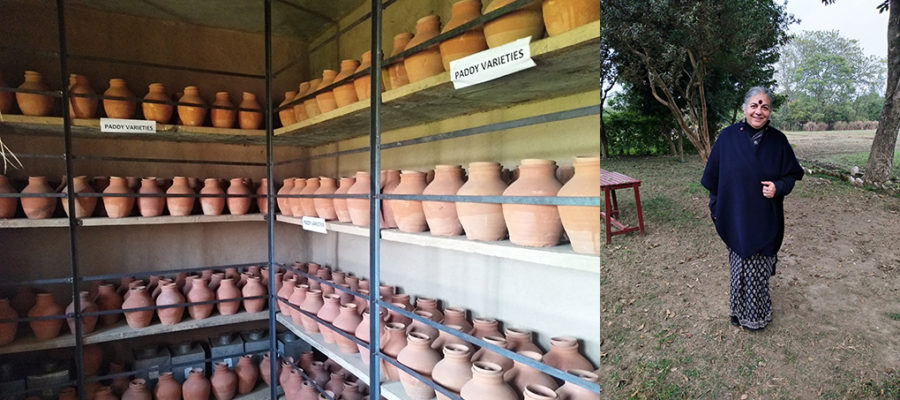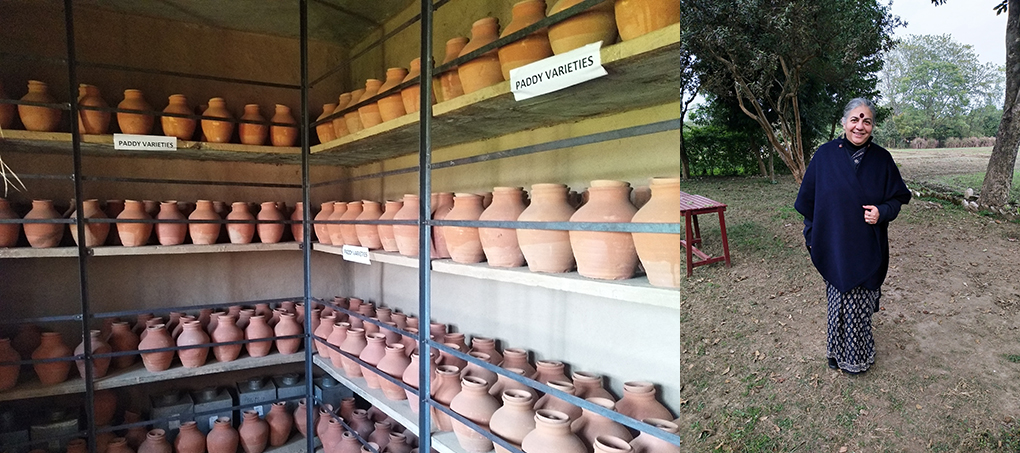
By Sapna Gopal – Thirdpole.net, 29 January 2020 | Source
Vandana Shiva, a pioneer of organic farming in India, is incensed by the 2019 draft law to compulsorily register all seeds used by farmers
On a wintry afternoon, at her farm Navdanya in the Himalayan foothills, noted ecologist Vandana Shiva spoke on the future of the organic farming movement in India. Excerpts:
Q: What is your view on the Himalayas? How different from the plains is it as a terrain?
A: Agriculture in the Himalayas is diverse because every valley is different, every slope is different, every altitude is different – the North and South faces are different. So, biodiversity is even more important for mountainous regions and for the Himalayas in particular. This is because the difference between Himalayas and other mountains is, for instance in the Alps, there is snow in the winter and there is no agriculture during that time – our peak agriculture season is the monsoon and we get it in four months. So, to not consider biodiversity while planning agriculture is a recipe for ecological disaster as it was for forestry which is why the Chipko movement started – which is how I started my ecological life, 45 years ago.
Q: Do you think there is a revolution in organic farming in India? Do you think the demand for organic produce is much more now and there’s heightened awareness in this regard? If yes, is this good news for the Indian market and the overseas market?
A: There are three levels on which the awareness on organic is growing — we have all worked for 35 years to build this movement. Beginning with a network of people concerned, we started Samvardhan, from Gandhi’s ashram in the early 80s. Then, my book, Violence of the green revolution, is the work that made me realise that we had to give up chemicals and move to organic. So, in a lot of places, it is a revolution happening because the green revolution has destroyed water (since it uses ten times the water). As a result, people are shifting, because there’s no way we can continue to deplete the last drop of water. Farmers are also shifting because the cost of chemical agriculture is so high that it is trapping farmers in debt – 77% of them are in debt. This is for input purchase, not for marriages or wastage of money, but for input of agriculture that’s based on chemicals. Also, it is capital intensive and the fact is that there are 400,000 suicides among indebted peasants in India [over the last few decades]. All these are helping farmers wake up to the fact that this kind of agriculture is not for them.
Then, there are people in the cities who are realising that most of their health problems are related to food and we know that chronic diseases are food related. This being the case, it’s better to shift to organic since it is the best medicine. As Ayurveda says, annam sarvodayi [food as universal upliftement], so that is the shift.
Over the years, I have worked with many states and we have helped around seven of them make a shift towards organic policies. They include Uttarakhand, Kerala (where the movement is very strong and is spreading very fast), Madhya Pradesh, Sikkim (the first 100% organic state in the world), Bihar and Odisha. Now, the government in Odisha has declared an organic policy and our colleagues in Odisha are on the board of the organic policy team. Ladakh as a region (before all the political changes), declared itself organic.
Outside India, the government of Bhutan is totally committed to moving towards organic, and we have helped give advice. So, it is a movement that must grow because there is no other way to farm. In any case, the big companies that draw the chemicals are saying, we don’t need farmers now. We will do farming without farmers. And worse, they are also saying, we don’t need food either – we will just cook together constituents in the lab – so between no farmer and no food, the alternative that will work, for the farmer, for the earth, for the people who have to eat, will be organic. So, no matter how much of a denial takes place, this is the future.
Q: Do you think there is a problem in terms of certification for organic farmers? Are there some policies which could help address this issue?
A: In the first instance, I remember going into the commerce ministry and saying, why on earth are organic standards being set by the commerce ministry? Our certification is too heavily driven by European standards. I was on the National Organic Board and we said that farmers can’t afford this – so, what was done was that we created group certification. In fact, Navdanya works through group certification — 100 farmers get together and then the overheads come down. In 2018, the United Nations Framework Convention on Climate Change (UNFCCC) tried to take over the organic standards and were going to make it impossible for any farmer to distribute food, even locally, without certification cost. I recollect fighting it out and saying, “No, where farmers are growing food either for themselves or those they know and directly selling it, the state will not enter in that domain, you don’t need certification, you need relationship,” and we managed to get that exclusion in the national law.
However, it’s a permanent fight because there are those who do want to destroy the small farmer. Which is why for us in Navdanya, from the time I founded it, it is beej swaraj (seed sefl-rule) and ann swaraj (food self-rule) – so, we have to have swaraj (self-rule, freedom) in our seed and in our food.
We wrote the laws on seed, we got rid of patenting in our laws, we wrote the farmers rights law. I have been part of drafting these laws, 10 to 15 years ago, and we did a satyagraha against seed law that would have made compulsory registration of seed, like compulsory certification of food. However, they have come back with a worse draft in 2019, something that was defeated in 2004. So, you can see that the powers of the industry are strong.
Q: We have witnessed a lot of suicides by farmers in India. Where does the solution lie?
A: The solution comes from understanding the cause, which is debt. Due to debt, there is loss of the land of the farmer. Of all the suicides that I have studied, if I have been in a region where the farmer has committed suicide, the story always goes that the latter went to his field to take one last look, bought pesticide, and drank it in his field.
Why doesn’t a farmer commit suicide in his home and why the field? That is because in India, most smallholder farmers have received that land through generations of farming and the day the creditors, who are agents of the corporations, come to say that now your land is ours because you did not pay the debt – if he says he never mortgaged his land, he is told that he signed a paper – the shock of being cheated, the disaster of feeling he has betrayed mother earth, all his ancestors who had this land, is what leads to these suicides.
So, why does the farmer get into debt? I watched this in the area of BT Cotton – they are told to sign a piece of paper. The seeds are given for free, but the farmer does not realise he is being piled under debt. Worse, the seeds keep failing, because they are not designed for a drought prone area and are hybrids. They can’t be saved, they can’t control pests – therefore, all these false promises that are made, compel the farmer to constantly go back to the market and take more and more seed, not realising that it is all on credit.
I think it is wrong for a government to say replace your seed and take bad seeds – what kind of government is this? Forcing bad seeds in the name of seed replacement for farmers – it is really anti-national, which is why I do satyagraha against all this. The government’s public breeding has stopped – I filed an RTI (Right to Information petition) and wanted to know how many seeds the Cotton Research Institute had released and why farmers are not buying it. It was found that there wasn’t a single release in Vidarbha.
When I did a study and did not see an alternative, I decided we would bring back the old cotton seed. In villages where we work in, 60% of the (genetically modified) BT cotton has gone.

